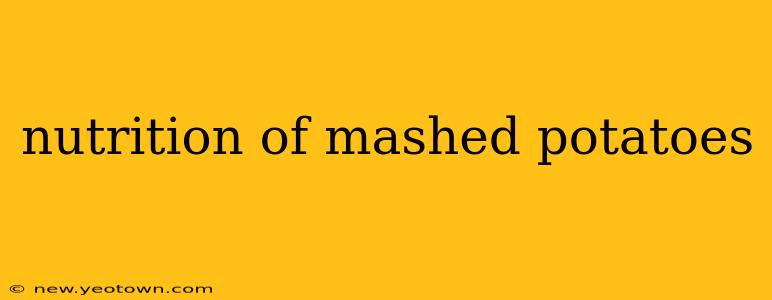Mashed potatoes. The creamy, comforting side dish that’s a staple at countless family dinners and holiday feasts. But beyond its deliciousness, what's the real nutritional story behind this beloved classic? It's more complex than you might think, and understanding the nutritional profile can help you enjoy this treat mindfully.
Let's embark on a journey into the world of mashed potato nutrition, uncovering its surprising benefits and potential drawbacks. We'll even address some frequently asked questions along the way.
Are Mashed Potatoes Healthy?
The simple answer is: it depends. The nutritional value of mashed potatoes hinges heavily on a few key factors: the type of potato used, the cooking method, and, perhaps most importantly, what you add to them. Russet potatoes, a popular choice for mashing, are a decent source of potassium, a mineral crucial for maintaining healthy blood pressure. They also contain vitamin C, although some is lost during cooking. However, mashed potatoes can also be high in carbohydrates and calories, especially when laden with butter, cream, milk, or cheese.
What are the Nutritional Benefits of Mashed Potatoes?
Despite their reputation as a carb-heavy side, mashed potatoes can offer some nutritional benefits. Remember, we're focusing on plain mashed potatoes here, made with minimal additions:
- Potassium: Russet potatoes are a good source of this essential mineral, which plays a vital role in regulating blood pressure and muscle function.
- Vitamin C: While some vitamin C is lost during the cooking process, a serving of plain mashed potatoes still provides a modest amount. This antioxidant is vital for immune function and collagen production.
- Fiber: While not as high in fiber as some other vegetables, potatoes still offer a small amount of dietary fiber, which aids digestion and promotes gut health. Leaving the skins on during preparation can significantly boost the fiber content.
How Many Calories are in Mashed Potatoes?
The calorie count in mashed potatoes varies greatly depending on the ingredients and portion size. A single serving (around ½ cup) of plain mashed potatoes made with russet potatoes can contain approximately 100-150 calories. However, adding butter, cream, milk, or cheese can quickly inflate this number. A creamy, loaded version can easily reach 200-300 calories or more per serving.
What are the Disadvantages of Eating Mashed Potatoes?
While mashed potatoes offer some nutritional value, they also come with certain considerations:
- High Carbohydrate Content: They are predominantly carbohydrates, which can be problematic for people managing blood sugar levels or following low-carb diets.
- Glycemic Index: Mashed potatoes have a relatively high glycemic index (GI), meaning they can cause a rapid spike in blood sugar. This effect is amplified by the addition of fats and other ingredients.
- Potential for High Sodium Content: Added salt significantly increases the sodium content, which can be detrimental for individuals with high blood pressure.
Are Sweet Potatoes Healthier Than Russet Potatoes for Mashing?
Yes, sweet potatoes generally offer a more nutritious profile compared to russet potatoes for mashing. They are packed with beta-carotene (which your body converts to vitamin A), fiber, and various antioxidants. However, they also have a higher sugar content. The best choice depends on your individual dietary needs and preferences.
How to Make Mashed Potatoes Healthier
The key to healthier mashed potatoes lies in mindful preparation:
- Choose the Right Potato: Opt for russet potatoes or sweet potatoes.
- Minimize Added Fats: Use minimal butter, milk, or cream, or try healthier alternatives like unsweetened applesauce or Greek yogurt.
- Season Wisely: Instead of relying heavily on salt, experiment with herbs, spices, and citrus zest for flavor.
- Leave the Skins On: This adds valuable fiber and nutrients.
- Control Portion Sizes: Be mindful of how much you're eating.
In conclusion, the nutritional profile of mashed potatoes is far from a simple yes or no. By understanding the factors that influence their nutritional value and making conscious choices about preparation and ingredients, you can enjoy this beloved dish while maintaining a balanced and healthy diet. It’s all about balance and mindful consumption!

